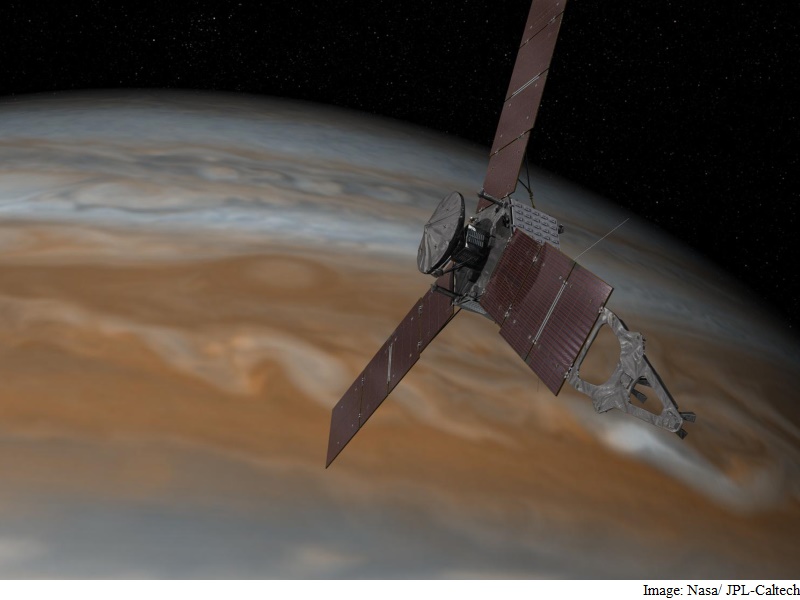- Home
- Science
- Science News
- Nasa's Juno Probe Inches Closer to Jupiter
Nasa's Juno Probe Inches Closer to Jupiter

The mission is now 26 days and 17.8 million kilometres away from Jupiter, the US space agency said in a statement on Thursday.
On the evening of July 4, Juno will fire its main engine for 35 minutes, placing it into a polar orbit around the gas giant, it added.
Giant Jupiter lies in the harshest radiation environment known, and Juno has been specially designed to safely navigate the brand new territory.
"We're currently closing the distance between us and Jupiter at about four miles per second," said Scott Bolton, principal investigator for Juno from the Southwest Research Institute in San Antonio.
"But Jupiter's gravity is tugging at us harder every day and by the time we arrive we'll be accelerated to 10 times that speed - more than 40 miles per second (nearly 70 kilometres per second) - by the time our rocket engine puts on the brakes to get us into orbit," Bolton added.
The Juno mission team is using these last weeks to evaluate and re-evaluate every portion of the Jupiter orbit insertion (JOI) process, finding very low probability events and running them to ground - determining which, if any, need to be addressed.
Two scenarios have been identified for further work. The first is a variation in how Juno would come out of safe mode ,a protective mode if the spacecraft were to encounter an anomaly or unexpected condition. A second item involves a minor software update.
"We are in the last test and review phases of the JOI sequence as part of our final preparations for Jupiter orbit insertion," Rick Nybakken, project manager of Juno for Nasa's Jet Propulsion Laboratory in Pasadena, California, pointed out.
"Throughout the project, including operations, our review process has looked for the likely, the unlikely and then the very unlikely. Now we are looking at extremely unlikely events that orbit insertion could throw at us," Nybakken said.
The Juno mission was launched on August 5, 2011 with the primary aim of improving our understanding of the solar system's beginnings by revealing the origin and evolution of Jupiter.
With its suite of science instruments, Juno will investigate the existence of a solid planetary core, map Jupiter's intense magnetic field, measure the amount of water and ammonia in the deep atmosphere, and observe the planet's auroras, according to Nasa's mission profile.
Catch the latest from the Consumer Electronics Show on Gadgets 360, at our CES 2026 hub.
Related Stories
- Samsung Galaxy Unpacked 2025
- ChatGPT
- Redmi Note 14 Pro+
- iPhone 16
- Apple Vision Pro
- Oneplus 12
- OnePlus Nord CE 3 Lite 5G
- iPhone 13
- Xiaomi 14 Pro
- Oppo Find N3
- Tecno Spark Go (2023)
- Realme V30
- Best Phones Under 25000
- Samsung Galaxy S24 Series
- Cryptocurrency
- iQoo 12
- Samsung Galaxy S24 Ultra
- Giottus
- Samsung Galaxy Z Flip 5
- Apple 'Scary Fast'
- Housefull 5
- GoPro Hero 12 Black Review
- Invincible Season 2
- JioGlass
- HD Ready TV
- Laptop Under 50000
- Smartwatch Under 10000
- Latest Mobile Phones
- Compare Phones
- iQOO Z11 Turbo
- OPPO A6c
- Samsung Galaxy A07 5G
- Vivo Y500i
- OnePlus Turbo 6V
- OnePlus Turbo 6
- Itel Zeno 20 Max
- OPPO Reno 15 Pro Mini 5G
- Lenovo Yoga Slim 7x (2025)
- Lenovo Yoga Slim 7a
- Realme Pad 3
- OPPO Pad Air 5
- Garmin Quatix 8 Pro
- NoiseFit Pro 6R
- Haier H5E Series
- Acerpure Nitro Z Series 100-inch QLED TV
- Asus ROG Ally
- Nintendo Switch Lite
- Haier 1.6 Ton 5 Star Inverter Split AC (HSU19G-MZAID5BN-INV)
- Haier 1.6 Ton 5 Star Inverter Split AC (HSU19G-MZAIM5BN-INV)

















